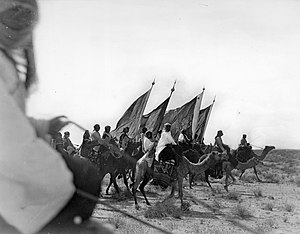| Ikhwan raids on Transjordan | |||||||
|---|---|---|---|---|---|---|---|
| Part of Unification of Saudi Arabia | |||||||
| |||||||
| Belligerents | |||||||
| Ikhwan ('Utaybah tribe) |
| ||||||
| Commanders and leaders | |||||||
| the first raid in 1922 leader is Ogab bin mohaia , and the second raid in 1924 leader is sultan bin Bajad | |||||||
| Strength | |||||||
|
1,500 raiders (1922) 3,000-4,000[1] or 4,500[2] camel raiders | |||||||
| Casualties and losses | |||||||
| 500+[2] killed (1924) | 130 tribesmen killed or wounded (1924)[1] | ||||||
|
Population of two small villages massacred[3] | |||||||
| |||||

Ikhwan on the move
Ikhwan raids on Transjordan were a series of plunders by the Ikhwan, irregular Arab tribesmen of Najd, on Transjordan between 1922 and 1924. The repeated Wahhabi incursions from Najd into southern parts of his territory were the most serious threat to emir Abdullah's position in Transjordan.[4] The emir was powerless to repel those raids by himself, thus the British maintained a military base, with a small air force, at Marka, close to Amman.[4] The British military force was the primary obstacle against the Ikhwan, helping emir Abdullah to secure his rule over Transjordan.[4]
Background[]
With the defeat of the Hashemites in the Nejd-Hejaz War of 1919, and a failture to establish a Hashemite domain over greater Syria, the British hoped to secure Transjordan and Iraq as client Hashemite Kingdoms, and did put a significant effort to secure them from external and internal threats. The military assistance of the British to emir Abdullah of Transjordan was used to help with the suppression of local rebellions at Kura and later by Sultan Adwan, in 1921 and 1923 respectively. They also played a crucial role in the major invasions by the Wahhabi tribesmen of Nejd (the Ikhwan).
First major raid[]
The Ikhwan initiated their first long range raid on Amman, with participation of some 1,500 camel raiders. According to Guckian, the raiders dissipated upon spotting a British aircraft approaching their column, and never reached Amman.[2] On the other hand, Wilson and Graham claim the intent of the raid was two small villages, which were entirely massacred, and the raiding Ikhwan party was intercepted by British armored cars and planes on their way back to the Kingdom.[3]
Second major raid[]
In August 1924, a larger Ikhwan militia force, numbering some 4,500 raiders,[2] travelled 1,600 kilometers from Najd (in modern day Saudi Arabia) to attack Transjordan, which was at that time under British protectorate. Just 15 kilometers off Amman, the raiders were spotted by the British RAF, which in turn attacked the Ikhwan using airplanes. The Ikhwan army suffered heavy casualties, with death toll reaching 500.[2] Without the help of the RAF, Amman would most likely been captured by the Ikhwans.[2]
Aftermath[]
Other raids of Ikhwan occurred during the 1927-1930 Ikhwan Revolt against the authority of Ibn Saud. The Ikhwanis raided on southern Iraq in November 1927, and on Kuwait in January 1928, in which they looted camels and sheep. On both occasions, though they raided brutally, they suffered heavy retaliations from RAF and Kuwaitis.[5] The Ikhwan were eventually defeated by Ibn Saud's regular forces and their leadership slain. The remants were incorporated into regular Saudi units.
See also[]
- Sultan bin Najad
- Kuwait-Najd Border War
- Saudi Arabian National Guard
- List of modern conflicts in the Middle East
References[]
- ↑ 1.0 1.1 1.2 [1]
- ↑ 2.0 2.1 2.2 2.3 2.4 2.5 Noel Joseph Guckian. British Relations with Trans-Jordan, 1920-1930. University College of Wales, Aberystwyth. Ph.D Thesis: pp.217-218. May 1985.
- ↑ 3.0 3.1 Peter W. Wilson, Douglas Graham. Saudi Arabia: the coming storm . M.E.Sharpe, 1994: p.143
- ↑ 4.0 4.1 4.2 Salibi, Kamal S. The modern history of Jordan. p. 104
- ↑ Peter W. Wilson, Douglas Graham. Saudi Arabia: the coming storm . M.E.Sharpe, 1994: p.45
The original article can be found at Ikhwan raids on Transjordan and the edit history here.